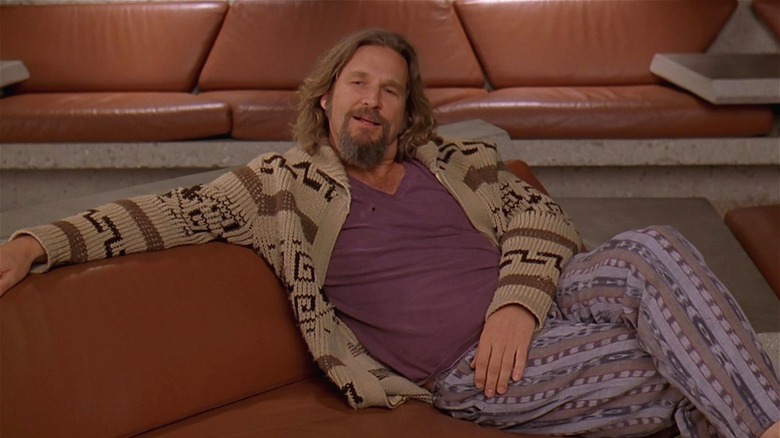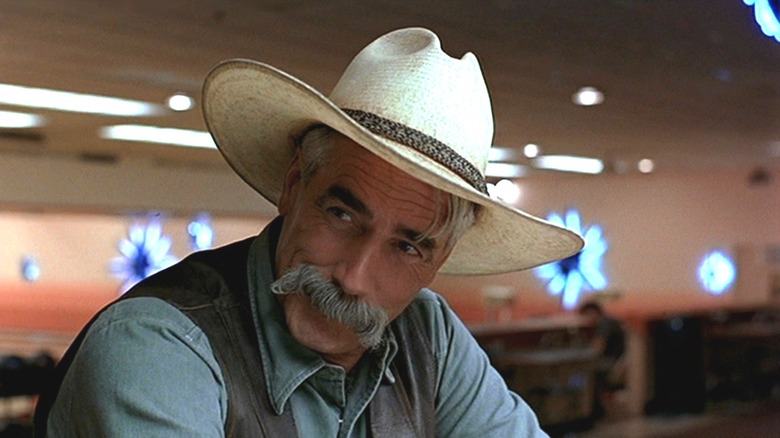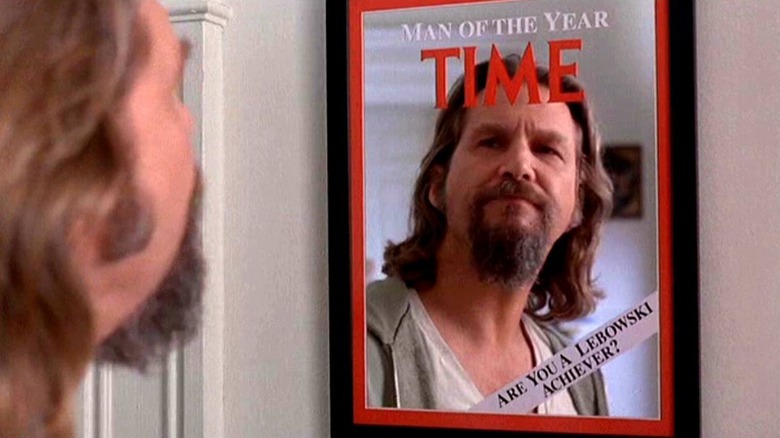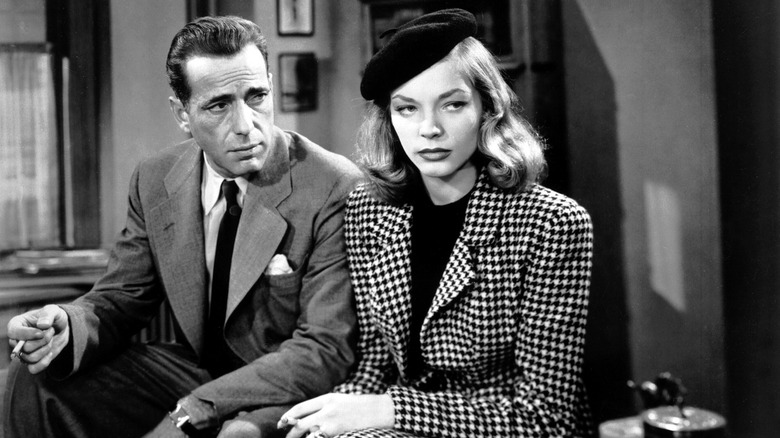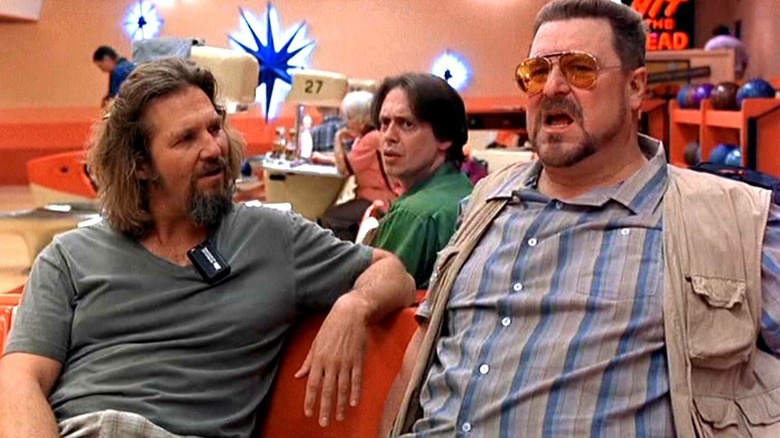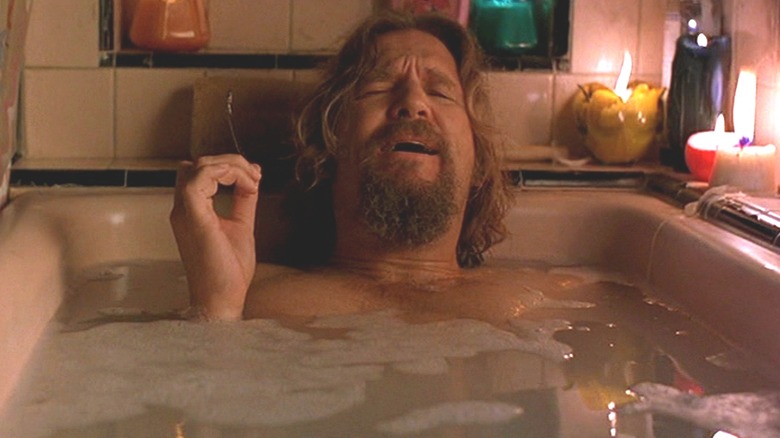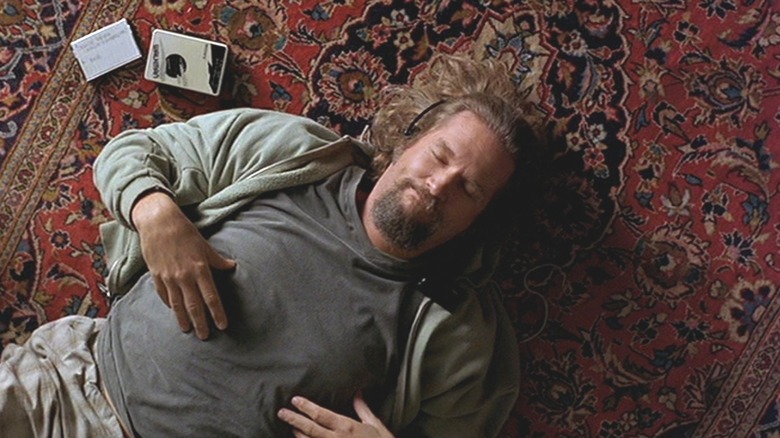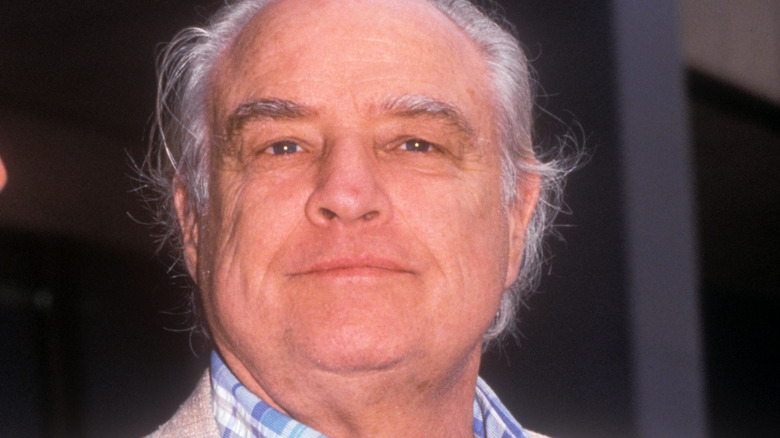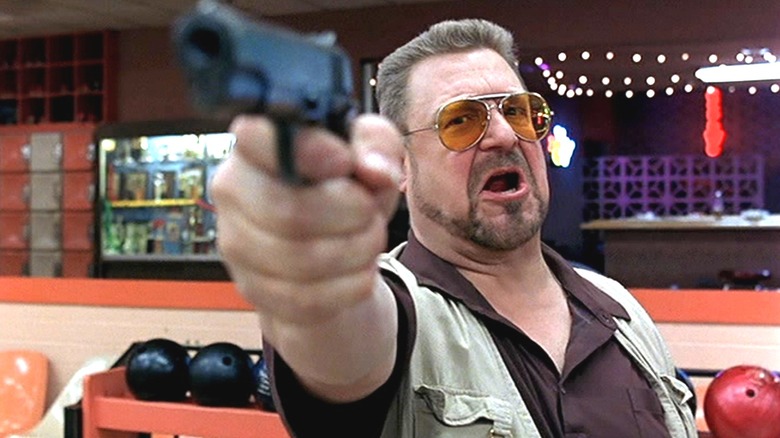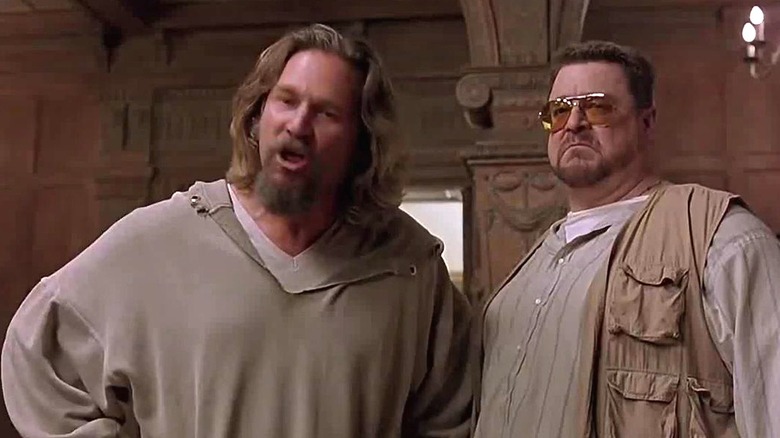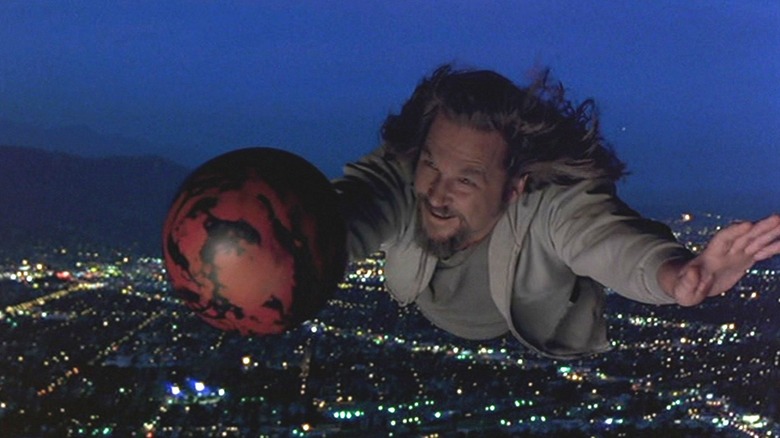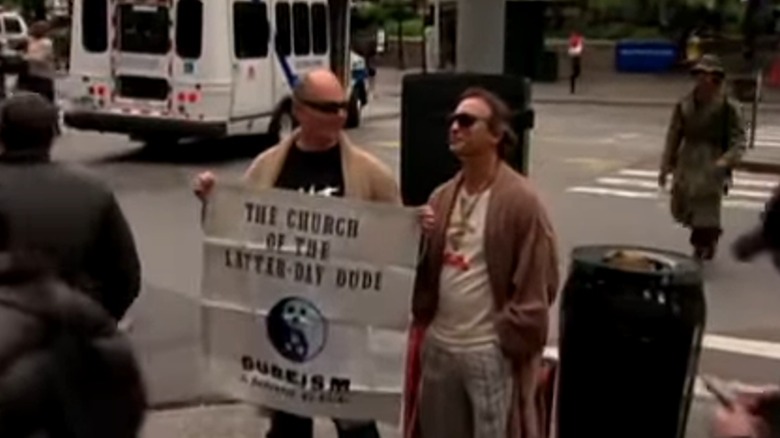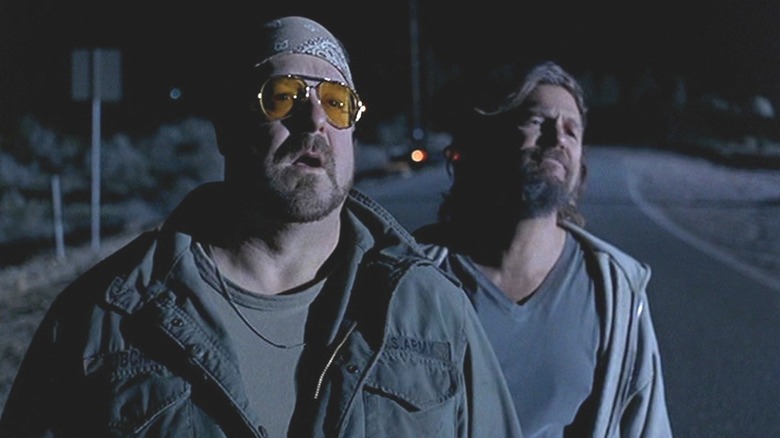The Untold Truth Of The Big Lebowski
In 1998, Joel and Ethan Coen released one of their strangest, funniest, and most beloved films. "The Big Lebowski" didn't do well when it was first released – which isn't unusual for a Coen Brothers movie – but it didn't take long for it to become a cult classic. The film features eccentric characters that run the gamut from relatively unusual to completely outrageous. Some are nihilists, while others are blowhards who think the world revolves around them. And at the center of them all is the Dude.
The enigmatic protagonist is propelled through an adventure he'd rather sit out, and of course, hilarity ensues. The film is surreal in places and is elevated by idiosyncratic dialogue that captivates and confounds. "The Big Lebowski" is a genuinely unusual and unique film, and it's no surprise that the movie achieved cult status, and is still beloved by many.
Like any Coen Brothers film, "The Big Lebowski" has a ton of interesting behind-the-scenes details that make it even more fascinating. These are the secrets behind the making of "The Big Lebowski," and how they all came together to produce a fantastic — if unusual — movie that stands the test of time.
The Stranger could only be played by Sam Elliott
"The Big Lebowski" opens and closes with narration provided by Sam Elliott in the role of the Stranger, establishing the setting and summarizing what happened in the film. Elliott also makes an appearance and has a short talk with the Dude at the bowling alley bar, and he's just as smooth and cool as he always is on screen. The Stranger is a role that only Elliott could play, and that's by design.
When he received the script, Elliot was surprised to see his name already on it. The actor explained to NPR, "Over the dialogue, there's this tumbling tumbleweed blowing and talk about this Southwest accent and, 'Sounding not unlike Sam Elliott.' They had my name in the script. And then I read further, and you see the character come into the bowling alley, and he's dressed like a drugstore cowboy or whatever he's dressed like. And looking 'not unlike Sam Elliot.'"
Elliott began acting in the late '60s, landing a one-liner role in his first feature film, "Butch Cassidy and the Sundance Kid." After that, he jumped from one similar role to another, often playing cowboys. Over time, Elliott embraced the role and didn't mind being typecast. "I got over being anything but thankful for being in any kind of a box — Western or not. It's been a rich life."
Jeff Bridges scored the role of The Dude via a Hollywood shindig
At the center of "The Big Lebowski" is the Dude, a man who loves to bowl, smoke weed, and do little else. Jeff Bridges plays the Dude, and it turns out the actor had a lot in common with the character. He first met the Coens at a party, and, according to Bridges, they told him, "We're writing something for you, man." Bridges was intrigued, having been a fan of their work since "Blood Simple," their first film released in 1984.
Sometime after the party, the Coens got their script in front of the actor. When he read through it, Bridges immediately noticed that the character was pretty much what he was like in high school. Bridges hadn't played a part like the one the Coens wrote, and the similarities to his younger self only increased his interest in playing the Dude.
Bridges jumped on the opportunity to relive his high school days and work with the Coens. The actor discussed the film on the "Smartless" podcast: "We had such a good time, man. When that movie came out, it didn't do well here. It did kinda well after the fact. But nobody really got it." Fortunately, many viewers around the world did eventually get it, and "The Big Lebowski" racked up tons of awards and nominations, with Bridges receiving a Satellite Award nomination for best actor.
The film was inspired by Raymond Chandler's The Big Sleep
The Coen Brothers often look to other sources for inspiration, and you can see this throughout their work. "The Big Lebowski" is no different, though its inspiration may escape most modern moviegoers. The Coens looked to Raymond Chandler, a 20th century novelist who specialized in detective fiction. "The Big Sleep" was Chandler's first novel, and this inspired "The Big Lebowski."
In "The Big Sleep," Philip Marlowe (Humphrey Bogart) is hired to handle a blackmail case dealing with a man's daughter. It turns out that the mystery is more complicated than advertised, and the plot diverges into two distinct narratives that drift apart, ultimately becoming completely different. You can see the similarities between "The Big Lebowski" and its inspiration, and they both include references to lewd photography — though "The Big Lebowski" uses pornography instead of photographs.
Joel Coen explained how they developed the structure using Chandler's work as a guide. "In this particular case, the story was ... very loosely based on the narrative structure of a Chandler novel. Those novels are very episodic in nature. They usually follow the main character as he encounters these different characters on a journey to uncover a mystery or find a missing person, or whatever it may be in the novel. In this case, that was the model for this story."
The plot doesn't matter at all
If you've seen "The Big Lebowski," you probably remember the plot. It's about a man mistaken for another man with the same name. A guy pees on his rug, and there's a ransom somewhere in there with nihilists hoping for a payday. The fairly straightforward plot isn't really what the movie is about. That's not how films typically work, but when you think about it, the plot of "The Big Lebowski" doesn't matter, as Joel Coen explained, "With this one, we sort of figured, you know, if things become a little bit too complicated or unclear, it really doesn't matter. I mean ... the plot is sort of secondary to the other things that are sort of going on in the piece. I think that if people get a little confused, it's not necessarily going to get in the way of them enjoying the movie."
Essentially, the plot doesn't matter nearly as much as the characters. Think about the characters in the movie, and you'll probably build a more complete story than you would by thinking solely about the plot. This type of storytelling mimics the structure common in film noir, and at the center is the Dude. Believe it or not, the Dude is in every single scene, which fully supports the noir structure popularized by Raymond Chandler.
The Dude slamming The Eagles scored music from The Rolling Stones
It's made very clear in the movie that the Dude doesn't like The Eagles. He even gets thrown out of a cab for complaining about the driver's music and isn't shy about expressing his disdain for the band. This small aspect of the character served the filmmakers well because it opened the door to license music from The Rolling Stones at a tremendous deal.
The Rolling Stones track "Dead Flowers" — performed by Townes Van Zandt — is featured in the film, and when the Coen Brothers approached the band's former manager, Allen Klein, about licensing costs, he told them it would be $150,000. Klein was shown an early cut of the film after this initial conversation, and one particular line piqued his interest: when the Dude declares, "I hate the f****** Eagles, man!"
Klein loved the line and called T Bone Burnett, who developed the soundtrack for "The Big Lebowski." Not only did Klein approve the licensing agreement for "Dead Flowers," but he also waived the $150,000 fee (per Far Out Magazine). The Rolling Stones' music is in countless films despite the hefty price tag, and waiving it entirely was a big deal for the Coens' production which had a relatively small budget of $15 million.
The rug really did tie it all together
Arguably the central plot point in "The Big Lebowski" is the Dude's beloved rug. After all, "That rug really tied the room together." After it gets peed on, the Dude visits the Big Lebowski (David Huddleston) to get a replacement, and this kicks off the rest of the story. The soiled rug takes a man of inaction and reluctantly puts him into action, and it is something the Dude has a great deal of pride in.
For the Dude, the rug represents pride in how he lives his life. He doesn't lie on a couch to listen to a recording of a bowling alley — he lays on his rug. The rug didn't just tie his room together, it tied his life together, and having this violated forces him to take action. The Coen Brothers didn't come up with this from a vacuum, in fact, they had real-world inspiration from Pete Exline, the man they used as the basis for the Dude.
Exline explained that he once had the brothers over for dinner and had a rug in his living room. The neighbors moved out and left it, so he used it, and he joked with the Coens that it "tied the room together." He brought this up repeatedly throughout the evening, and the Coens found it funny enough to base a movie on (via Shore Scripts).
The Coen Brothers wanted Marlon Brando to play The Big Lebowski
"The Big Lebowski" is all about the Dude, but the title doesn't refer to Jeffrey "The Dude" Lebowski. The so-called "Big Lebowski" (played by David Huddleston) is the wealthy philanthropist whose trophy wife, Bunny (Tara Reid), becomes the focus of the kidnapping and ransom plot. While he's not in the film as much as the Dude, the Big Lebowski is an important character, and the Coen Brothers wanted someone of equal prominence to play him. So they eyed none other than Marlon Brando.
Brando was one of several names the Coens kicked around, having considered and discarded a plethora of actors, including Lloyd Bridges, Jeff Bridges' father. Other names they tossed about included Michael Caine, Ned Beatty, George C. Scott, and many others. Still, they wanted Brando, as he was their ideal actor for the role. Unfortunately, it was little more than a pipe dream, as explained by Alex Belth in "The Dude Abides: The Coen Brothers & the Making of The Big Lebowski."
"It was a good dream, too, though unlikely. Brando had certainly grown into the role, but he was eccentric, expensive, and didn't much like to work. Still, the idea amused the boys no end, and for weeks they quoted the Big Lebowski's lines in a Brando accent: "Condolences, the bums lost," Joel said with his jaw pushed out to look like Brando in 'The Godfather'" (via Cinearchive).
The Coens based several characters on Hollywood elite
The Coen Brothers started working on "The Big Lebowski" in the early 1990s, basing several characters on real people. They based the Dude on two men: the first is Pete Exline, a Vietnam War veteran and faculty member at the University of Southern California. The second inspiration for the Dude was Jeff Dowd, a film producer the Coens worked with on "Blood Simple." In the '70s, Dowd was an anti-war political activist and a member of the Seattle Seven.
Dowd also referred to himself as "The Dude," so there's a lot of him in the character Bridges plays in the movie. Walter Sobchak (John Goodman) is another over-the-top character from the film based on a real person. Walter is a caricature of John Milius, the man best known for writing and directing a slew of hit movies, including Francis Ford Coppola's "Apocalypse Now" as well as the first two "Dirty Harry" films, "Conan the Barbarian," and "Red Dawn."
On top of his hefty resume, Milius is a fascinating man who refers to himself as a Nazi, is a gun nut, and is a bit over-the-top. The Coens wanted Milius to play a character in "Barton Fink," but he passed. Nearly a decade later, they created Walter with Milius in mind, and he doesn't just sound and act like the famous screenwriter, he also looks a lot like him.
The Coens kept a tight script, allowing only one improvised line
"The Big Lebowski" is a comedy, and if the genre is known for one thing, it's improv. Most comedies feature some improvisation, but the Coen Brothers aren't huge fans of this: They put so much work into their scripts that they usually don't allow any improvisation from their actors at all. Every use of the word "man" and every F-bomb in the script is intentional, and when shooting begins, the brothers don't do rewrites.
However, there is a single improvised line in "The Big Lebowski" that the directors let into the final cut. When the Dude talks to the Big Lebowski about how he used him, he says, "You just met me, you human paraquat." That line wasn't in the script, and Jeff Bridges convinced the directors to let him say it.
John Goodman, Jeff Bridges, and Steve Buscemi appeared on Today, explaining how the script seemed like "improvisation right on the page," but the only improv they could do was in rehearsal. Goodman confirmed the improvisation of the human paraquat line and referred to another, though he didn't expand on this. If you were wondering what paraquat is, it's a chemical used as a herbicide. So the Dude essentially called him a human buzzkill with a dash of eloquence that only he could deliver.
The Dude loves to bowl ... but not in the movie
The Dude loves only a few things: White Russians, marijuana, his rug, and bowling. Bowling is central to the plot, and the bowling alley features some of the film's best dialogue. When the Dude isn't at the bowling alley, he's often talking about bowling and he isn't the only one. His friends, especially Walter, refer to it often, and it's effectively their refuge from the world when things go awry ... which they seem to do regularly.
After Walter's plan to keep the money results in blowing the whole operation, he utters, "F*** it, Dude. Let's go bowling." It's clear to the audience that the Dude loves bowling, but it may surprise some viewers to learn that he doesn't bowl in the film — not once. He's in the bowling alley, sitting and talking to his friends while they bowl, but he doesn't get up to bowl himself.
The only time you see the Dude holding a ball or interacting with the various elements of a bowling alley is during a dream sequence. The dream plays out like a soft-core B-movie called "Gutterballs." It begins with Saddam Hussein handing the Dude bowling shoes and follows him as he dances and finally holds a bowling ball that he helps Maude (Julianne Moore) to throw. Instead of the ball, the Dude floats down the alley, and that's the closest he comes to bowling in the whole movie.
It spawned a religion and an annual festival
"The Big Lebowski" features a somewhat unusual lifestyle. The Dude lives a life of ease with little comfort, yet it's easy to see the appeal. He has no worries and follows a philosophy similar to Taoism but without any of the metaphysical aspects. The Dude's laidback philosophy on life has even inspired its own religion: Dudeism.
According to the Dudeism website, their faith is essentially a stripped-down form of Chinese Taoism as it originally existed. Dudeism's central tenets are "Smoke 'em if you got 'em" and "Mellow out, man." Dudeism has over 600,000 priests worldwide, and they celebrate The Day of the Dude every March 6 — the date the film dropped in 1998. A fan asked Jeff Bridges what he thought the Dude would think about Dudeism, and he said, "He'd be flabbergasted. And he would dig it" (via the Los Angeles Times).
In addition to a religion, the film also inspired an annual festival, the Lebowski Fest. The event began in 2002 in Louisville, Kentucky, and has grown in popularity nationwide. Bridges made an appearance at the 2005 Lebowski Fest in Los Angeles. Other stars, including John Goodman, Julianne Moore, Steve Buscemi, and John Turturro, have made similar appearances over the years.
The Coen's prolific use of the F-bomb made for some creative TV editing
The Coen Brothers put a lot of effort into the dialogue in "The Big Lebowski," and one word stands out above the rest. Unfortunately, it wouldn't be prudent to write it here, but you likely know it as the F-bomb, and it appears at a rate of two per minute in the film for a total count of 281 times (per Rolling Stone). That's certainly a lot of uses of the F-bomb, but it's hardly the most in movie history. Regardless, its prevalence created a problem for televised broadcasts.
When a movie runs on TV, it requires a lot of editing. There are usually cuts made to ensure the film fits into a timeslot, and actors dub over profanity to ensure viewers aren't hit with excessive F-bombs. When "The Big Lebowski" went through this editing process, it resulted in some of the strangest dialogue ever put to celluloid.
Usually, an actor can use another word instead of a profane one, which makes sense, but the dialogue in "The Big Lebowski" doesn't work great for substitution. One scene, in particular, stands as the funniest edit. When Walter gets his crowbar and destroys a car, he says, "You see what happens, Larry, when you find a stranger in the Alps?" This edited line doesn't make any sense whatsoever, but it still somehow works, given the absurdity of the moment.
